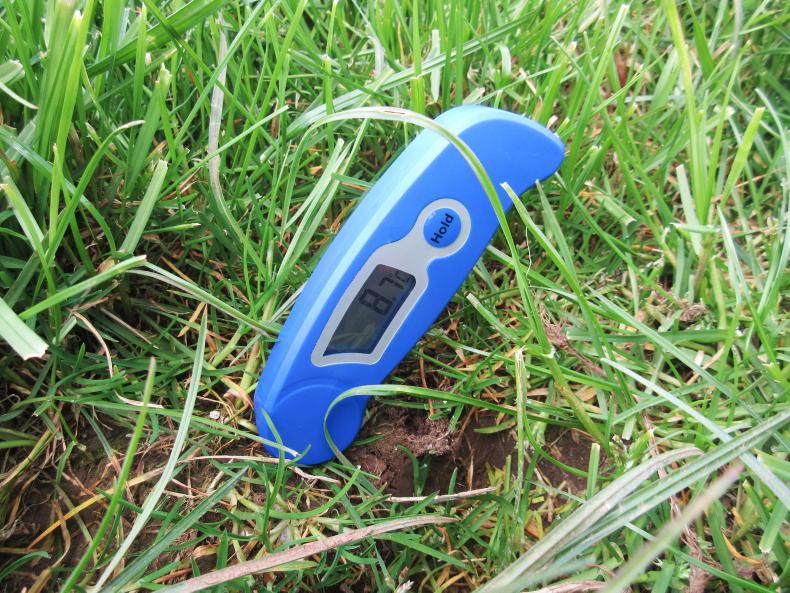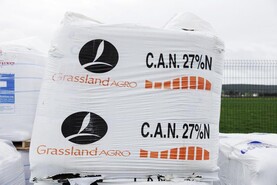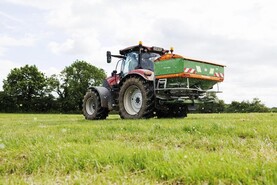With exceptional weather conditions over the last number of weeks and further mild weather forecast for next week, some beef farmers have started talking about fertiliser and wondering whether to buy now or hold off until later. It’s a difficult question to answer. Looking at international markets and across the water in the UK, fertiliser prices are dropping.
The same will happen here, however merchants that purchased fertiliser early in the season and before Christmas at high prices won’t be in any rush to sell at lower prices. New stock coming in from now on will come down in price however, so my advice would be to hold off until there is more downward pressure on price.
For the vast majority of drystock farms that are stocked at a relatively low level, there isn’t a big requirement for early fertiliser applications.
Dairy farms, on the other hand, do have a big requirement for early grass, so the current stocks are better headed to dairy yards. For drystock farms, any early nitrogen requirements should be fulfilled from slurry on the farm.

Low covers should recieve slurry at the rate of 2500 gallons/ac as soon as possible.
Drystock farms have a poor record in utilising slurry in spring for a variety of reasons, with poor ground conditions being the major one. The dry conditions over the last few weeks should help overcome this problem.
Ideally, your farm will have been closed off in three sections last October. The first third of the farm, which is usually the driest part, should have been closed off in October.
This is the first part of the farm that should be grazed in spring 2023 and should have a decent cover of grass (10-12cm) on it at this stage.
Once this grass is eaten, these grazed fields would be ideal for an application of watery slurry via trailing shoe or dribble bar at the rate of 2,000 gallons/ac. The second third of the farm should have a medium cover of grass (6-10cm) and this is ideal for fertiliser application.
Before any fertiliser spreading takes place, make sure soil conditions are good, there is no heavy rain forecast within the next 48 hours and that soil temperatures have been consistently above 6°C for a number of days. The idea is that if the grass plant is actively growing, there is a reduced risk of losing the valuable fertiliser that is being spread.
Table 1 outlines the current costs of urea fertiliser vs CAN fertiliser. This is based on urea costing €900/t, protected urea costing €950/t and CAN costing €700/t. Costs will vary depending on price.
Urea-based fertiliser offers the best value for money at the moment. Using protected urea will help lower the amount of greenhouse gas emissions emitted on your farm. Moderately stocked farms should be aiming to spread 30-40 units/ac of nitrogen on one-third of the farm in March.
For early nitrogen applications on drystock farms, target fields that are most likely to respond to an early N application:
Perennial ryegrass/recently reseeded fields.Fields with a grass cover of greater than 400kg DM/ha or 6cm grass.Fields with optimum soil fertility, i.e good phosphorus (P) and potassium (K) status, pH >6.2.The final third of the farm will be the area of the farm that was grazed last in November/December 2022. This area will have a low grass cover and will be ideal for a slurry application.
Aim to spread 2,500 gallons/ac on this area, which will deliver 20 units N/ac. This will be the final section of the farm to be grazed on the first round. Try to aim slurry at silage fields if you can, as silage will remove the most P and K.

Solid temperatures should be consistently above 6°C before any fertiliser spreading takes place.
Make sure the farm has been soil sampled recently and that pH is above 6.2 on all fields. If it isn’t liming time, plans should be put in place as soon as possible. Without the correct pH, you will not get the maximum efficiency out of fertiliser that has been spread.
Fertiliser spreader maintenance
Given that fertiliser is one of the most expensive farm inputs in 2023, it makes sense to give the fertiliser spreader a once over to make sure it is working properly from a spreading point of view.
Make sure that all relevant parts have been greased to ensure the fertiliser spreader is working properly. Double-check that you are familiar with the spreader operation mechanisms and consult the operator’s manual if you are unsure of PTO and forward spreading speeds. Make sure the spreader is sitting level on the arms of the tractor so that it spreads evenly.
In Short
Fertiliser prices are likely to drop more, so hold off buying any large amounts in bulk and just buy as you need it.Utilise slurry on the farm for any early nitrogen requirements and aim to spread 2,500 gallons/acre (20 units N/ac) of slurry on 66% of the farm as soon as possible.Make sure soil temperatures are consistently above 6°C before any fertiliser is spread.Protected urea is the safest and cheapest form of nitrogen you can spread on your farm.Check your soil pH and lime fields accordingly to maximise fertiliser efficiency.
With exceptional weather conditions over the last number of weeks and further mild weather forecast for next week, some beef farmers have started talking about fertiliser and wondering whether to buy now or hold off until later. It’s a difficult question to answer. Looking at international markets and across the water in the UK, fertiliser prices are dropping.
The same will happen here, however merchants that purchased fertiliser early in the season and before Christmas at high prices won’t be in any rush to sell at lower prices. New stock coming in from now on will come down in price however, so my advice would be to hold off until there is more downward pressure on price.
For the vast majority of drystock farms that are stocked at a relatively low level, there isn’t a big requirement for early fertiliser applications.
Dairy farms, on the other hand, do have a big requirement for early grass, so the current stocks are better headed to dairy yards. For drystock farms, any early nitrogen requirements should be fulfilled from slurry on the farm.

Low covers should recieve slurry at the rate of 2500 gallons/ac as soon as possible.
Drystock farms have a poor record in utilising slurry in spring for a variety of reasons, with poor ground conditions being the major one. The dry conditions over the last few weeks should help overcome this problem.
Ideally, your farm will have been closed off in three sections last October. The first third of the farm, which is usually the driest part, should have been closed off in October.
This is the first part of the farm that should be grazed in spring 2023 and should have a decent cover of grass (10-12cm) on it at this stage.
Once this grass is eaten, these grazed fields would be ideal for an application of watery slurry via trailing shoe or dribble bar at the rate of 2,000 gallons/ac. The second third of the farm should have a medium cover of grass (6-10cm) and this is ideal for fertiliser application.
Before any fertiliser spreading takes place, make sure soil conditions are good, there is no heavy rain forecast within the next 48 hours and that soil temperatures have been consistently above 6°C for a number of days. The idea is that if the grass plant is actively growing, there is a reduced risk of losing the valuable fertiliser that is being spread.
Table 1 outlines the current costs of urea fertiliser vs CAN fertiliser. This is based on urea costing €900/t, protected urea costing €950/t and CAN costing €700/t. Costs will vary depending on price.
Urea-based fertiliser offers the best value for money at the moment. Using protected urea will help lower the amount of greenhouse gas emissions emitted on your farm. Moderately stocked farms should be aiming to spread 30-40 units/ac of nitrogen on one-third of the farm in March.
For early nitrogen applications on drystock farms, target fields that are most likely to respond to an early N application:
Perennial ryegrass/recently reseeded fields.Fields with a grass cover of greater than 400kg DM/ha or 6cm grass.Fields with optimum soil fertility, i.e good phosphorus (P) and potassium (K) status, pH >6.2.The final third of the farm will be the area of the farm that was grazed last in November/December 2022. This area will have a low grass cover and will be ideal for a slurry application.
Aim to spread 2,500 gallons/ac on this area, which will deliver 20 units N/ac. This will be the final section of the farm to be grazed on the first round. Try to aim slurry at silage fields if you can, as silage will remove the most P and K.

Solid temperatures should be consistently above 6°C before any fertiliser spreading takes place.
Make sure the farm has been soil sampled recently and that pH is above 6.2 on all fields. If it isn’t liming time, plans should be put in place as soon as possible. Without the correct pH, you will not get the maximum efficiency out of fertiliser that has been spread.
Fertiliser spreader maintenance
Given that fertiliser is one of the most expensive farm inputs in 2023, it makes sense to give the fertiliser spreader a once over to make sure it is working properly from a spreading point of view.
Make sure that all relevant parts have been greased to ensure the fertiliser spreader is working properly. Double-check that you are familiar with the spreader operation mechanisms and consult the operator’s manual if you are unsure of PTO and forward spreading speeds. Make sure the spreader is sitting level on the arms of the tractor so that it spreads evenly.
In Short
Fertiliser prices are likely to drop more, so hold off buying any large amounts in bulk and just buy as you need it.Utilise slurry on the farm for any early nitrogen requirements and aim to spread 2,500 gallons/acre (20 units N/ac) of slurry on 66% of the farm as soon as possible.Make sure soil temperatures are consistently above 6°C before any fertiliser is spread.Protected urea is the safest and cheapest form of nitrogen you can spread on your farm.Check your soil pH and lime fields accordingly to maximise fertiliser efficiency. 







 This is a subscriber-only article
This is a subscriber-only article










SHARING OPTIONS: